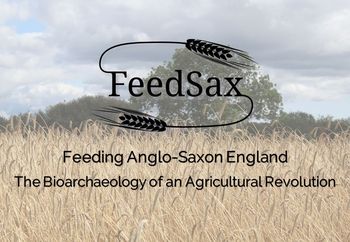Digital Archive for Feeding Anglo-Saxon England (FeedSax): The Bioarchaeology of an Agricultural Revolution, 2017-2022
Mark McKerracher, Amy Bogaard, Christopher Bronk Ramsey, Michael Charles, Emily Forster, Helena Hamerow, John Hodgson, Matilda Holmes, Samantha Neil, Tina Roushannafas, Elizabeth Stroud, Richard Thomas, 2023. https://doi.org/10.5284/1057492. How to cite using this DOI
Data copyright © Prof Helena Hamerow unless otherwise stated
This work is licensed under a Creative Commons Attribution 4.0 International License.
Primary contact
Prof
Helena
Hamerow
Institute of Archaeology
University of Oxford
36 Beaumont St
Oxford
OX1 2PG
England
Tel: 01865 278240
Fax: 01865 278254
Resource identifiers
- ADS Collection: 3605
- DOI:https://doi.org/10.5284/1057492
- How to cite using this DOI
Introduction

This collection comprises the digital archive for Feeding Anglo-Saxon England (FeedSax): The Bioarchaeology of an Agricultural Revolution.
Between the 8th and 13th centuries, the population of England grew to unprecedented levels. This could not have happened without a major expansion of arable farming, a development that culminated in the emergence of open-field agriculture. As well as feeding more people, the production of large cereal surpluses sustained the growth of towns and markets, and fuelled wealth inequality and the rise of lordship. Early medieval England thus witnessed a golden age of arable farming, in which the expansion of cultivation - 'cerealisation' - was the bedrock of demographic and economic growth. How, when and why this transformation occurred are some of the most enduring questions in British agricultural history, but more than a century of landscape-historical research has failed to produce a consensus.
The 'Feeding Anglo-Saxon England' (FeedSax) project addressed these longstanding conundrums by combining bioarchaeological data with evidence from settlement archaeology. Funded by the European Research Council under the European Union's Horizon 2020 programme (Advanced Grant 741751), the project ran from 2017 to 2022 at the Universities of Oxford and Leicester. The research team applied a suite of science-based techniques - including stable isotope analysis, functional weed ecology, animal palaeopathology and radiocarbon dating - to preserved grains, seeds, animal bones and pollen, to generate the first direct evidence for how crops were grown in this transformative period of history.
For further information, see the accompanying Internet Archaeology paper:
McKerracher, M. et al. 2023. Feeding Anglo-Saxon England: a bioarchaeological dataset for the study of early medieval agriculture. Data paper, Internet Archaeology 61. https://doi.org/10.11141/ia.61.5







